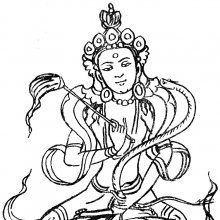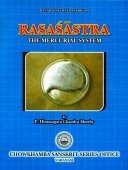Extraction: 1 definition
Introduction:
Extraction means something in Hinduism, Sanskrit. If you want to know the exact meaning, history, etymology or English translation of this term then check out the descriptions on this page. Add your comment or reference to a book if you want to contribute to this summary article.
Images (photo gallery)
In Hinduism
Natyashastra (theatrics and dramaturgy)
Source: Shodhganga: Elements of Art and Architecture in the Trtiyakhanda of the Visnudharmottarapurana (natya)Extraction (of thorns or splinters) is associated with the Agraja variety of Sandaṃśahasta: one of the twenty-two Single-hand Gestures (in Indian Dramas) (known as asaṃyuktahastas), according to the Viṣṇudharmottarapurāṇa, an ancient Sanskrit text which (being encyclopedic in nature) deals with a variety of cultural topics such as arts, architecture, music, grammar and astronomy.—The word sandaṃśa means kaṅkamukha i.e., a pair of tong. Tong is a kind of tool which is used to hold something. [...] The Viṣṇudharmottarapurāṇa speaks of three kinds this form viz., agraja, mukhaja and pārśvakṛta and it gives detailed discussion of the usages of each one clearly. The agraja-sandaṃśa-hasta is used for holding and extraction of thorns or splinters.

Natyashastra (नाट्यशास्त्र, nāṭyaśāstra) refers to both the ancient Indian tradition (shastra) of performing arts, (natya—theatrics, drama, dance, music), as well as the name of a Sanskrit work dealing with these subjects. It also teaches the rules for composing Dramatic plays (nataka), construction and performance of Theater, and Poetic works (kavya).
See also (Relevant definitions)
Full-text (+162): Abhyavakarshana, Shalyashastra, Nishkarsha, Ancana, Shalyakriya, Avakarshana, Shalyoddhara, Mulikarana, Nagakanya, Daushkulya, Nistarana, Suya, Shalyavaranga, Uddhriti, Niryata, Karshana, Garbhashanku, Uddharana, Musha, Khasatva.
Relevant text
Search found 64 books and stories containing Extraction; (plurals include: Extractions). You can also click to the full overview containing English textual excerpts. Below are direct links for the most relevant articles:
Chandogya Upanishad (Shankara Bhashya) (by Ganganatha Jha)
Section 3.16 (sixteenth khaṇḍa) (seven texts) < [Chapter 3 - Third Adhyāya]
Section 2.24 (twenty-fourth khaṇḍa) (sixteen texts) < [Chapter 2 - Second Adhyāya]
Section 3.12 (twelfth khaṇḍa) (nine texts) < [Chapter 3 - Third Adhyāya]
Manusmriti with the Commentary of Medhatithi (by Ganganatha Jha)
Verse 11.223 < [Section XXIX - Description of the Expiatory Penances]
Verse 11.123 < [Section XII - Expiation for the Immoral Religious Student (avakīrṇa)]
Verse 11.216 < [Section XXIX - Description of the Expiatory Penances]
Soma in Vedic Mythology and Ritual (study) (by Anjana Chakraborty)
Chapter 3(j) - The Final Purificatory Bath (Avabhritha)
Chapter 1(d) - A Discussion on Vedic Rituals
Yajnavalkya-smriti (Vyavaharadhyaya)—Critical study (by Kalita Nabanita)
Chapter 4.4 - Checks and Limitations on the King and Royal Officers < [Chapter 4 - The Political Aspect Reflected in the Vyavahārādhyāya]
Rasa Jala Nidhi, vol 3: Metals, Gems and other substances (by Bhudeb Mookerjee)
Part 8 - Extraction of oil from seeds of Putranjiba and Agasti < [Chapter XXXII - Extraction of oil from seeds]
Part 6 - Extraction of essence of Vaikranta < [Chapter XX - Gems (8): Vaikranta (garnet)]
Part 1 - Extraction of oil from seeds of any kind < [Chapter XXXII - Extraction of oil from seeds]
Rasa Jala Nidhi, vol 2: Minerals (uparasa) (by Bhudeb Mookerjee)
Part 3 - Extraction of essence of manas-shila < [Chapter XIII - Uparasa (14): Manahshila or Manas-shila (realgar)]
Part 3 - Extraction of essence from tuttha < [Chapter V - Uparasa (5-6): Tuttha and Sasyaka (copper sulphate)]
Part 7 - Extraction of essence of mica < [Chapter I - Uparasa (1): Abhra or Abhraka (mica)]
Related products





